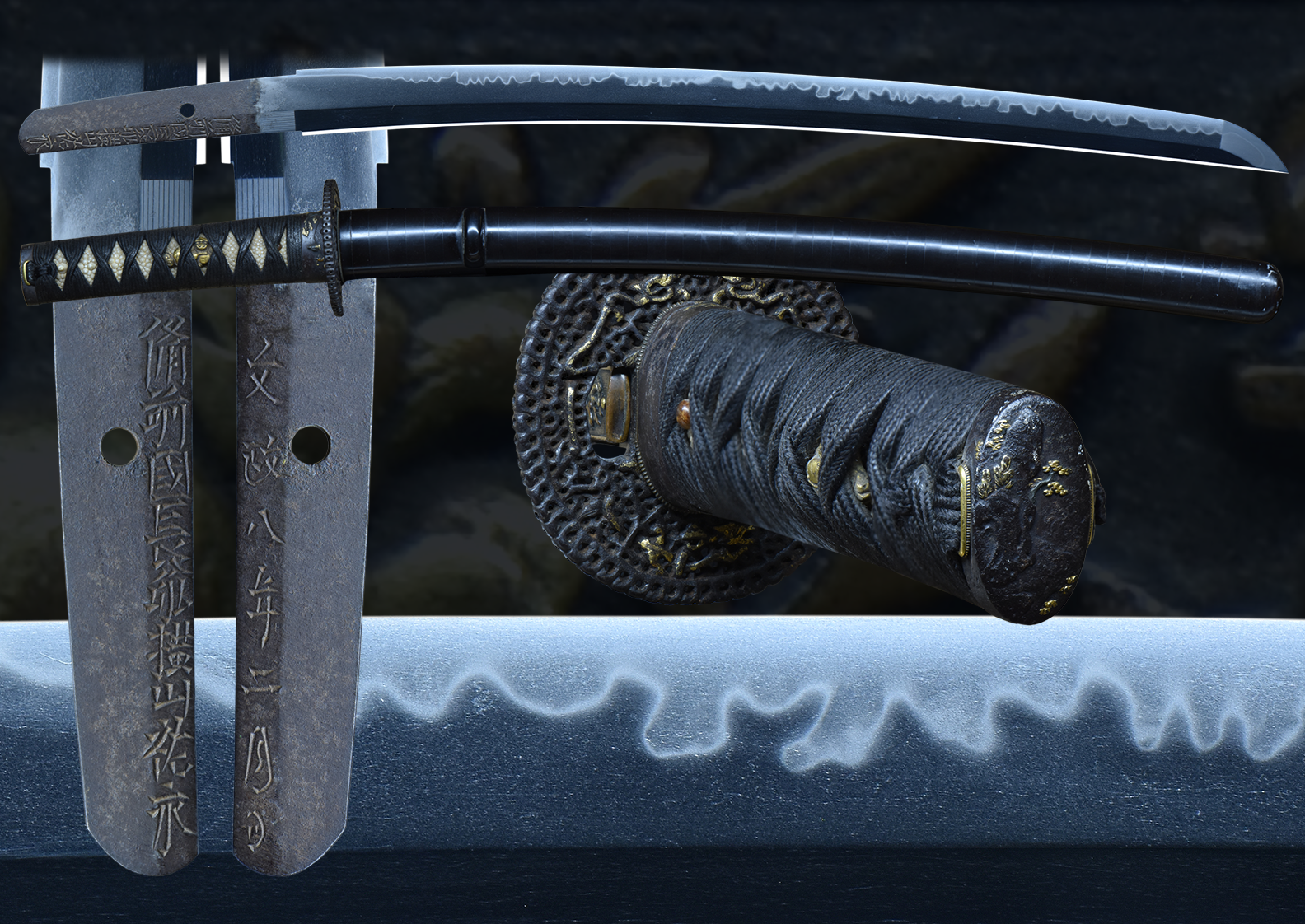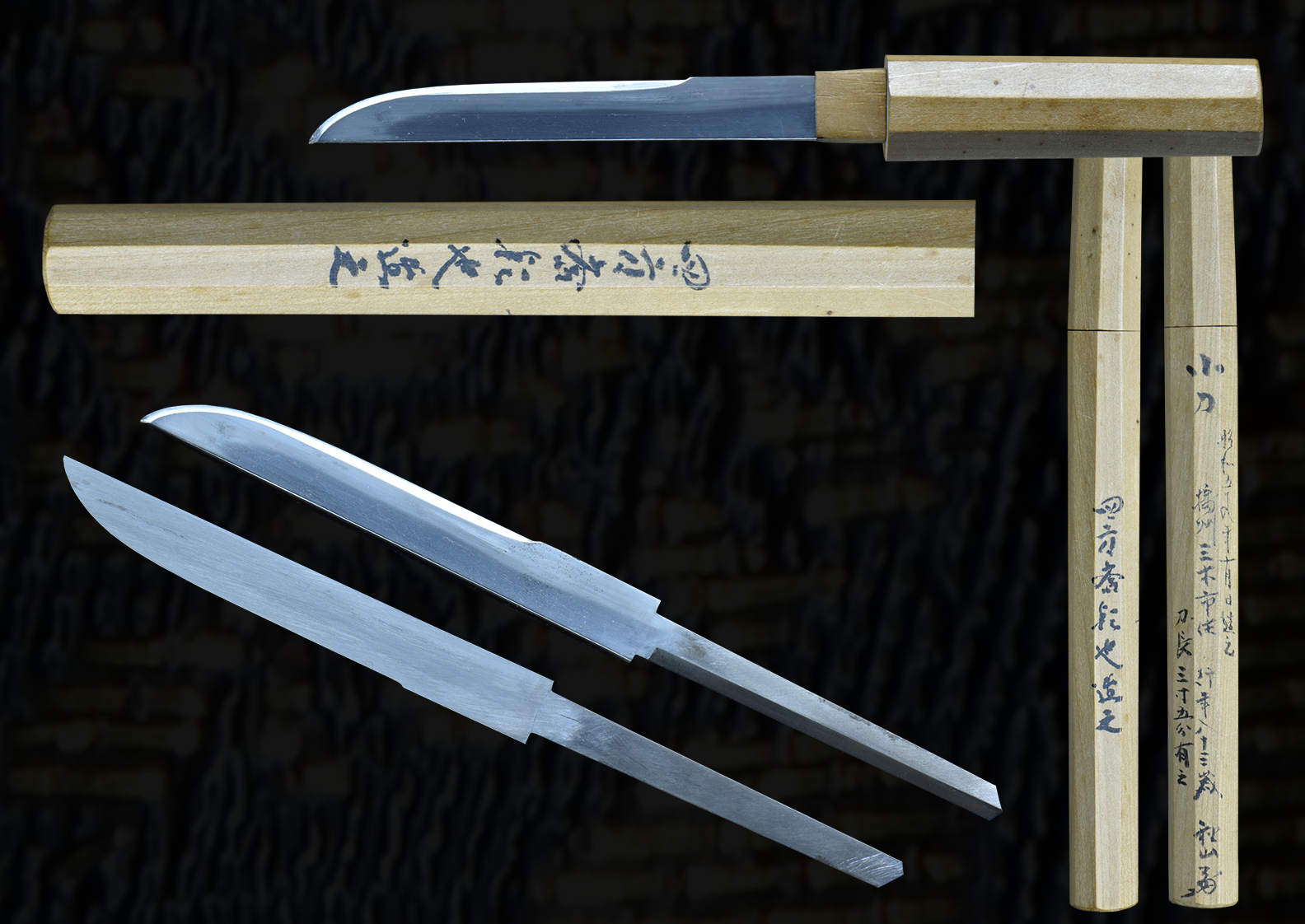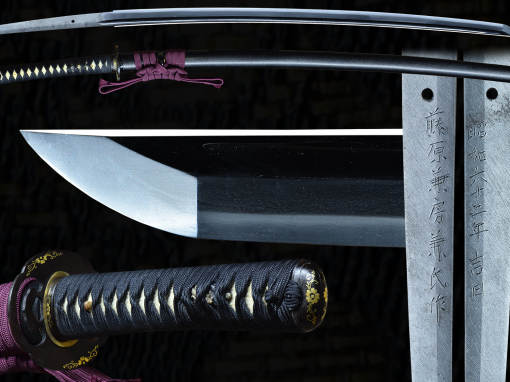Hamon : Ko-nie deki gunome midare increasing in width as it approaches the saki. There are kinsuji inazuma and sunagashi. There are ko-ashi and uchinoke.
Boshi : Midare-komi and hakekake with a short return on both sides.
Kitae : Hada-mono. O-mokume mixed with O-itame. Many chikei are present as well as ji-nie. There is tobiyaki and muneyaki.
This mumei blade has been attributed to Ikkansai Yoshihiro by the NBTHK. Yoshihiro was active around Bunsei (1818 – 1831) and worked in Edo. He held the position of Imperial Archives Keeper and is well-known for his Soshu den style. He often aimed at Norishige in his works and that can be seen in this example.
This blade is in old sashi-komi polish with some surface blemishes. There are some kitae ware in the ji. Please see the photos for full detials.
A translation of the Yoshihiro entry in the Toko Taikan (on page 775) is as follows : Yoshihiro: Active in Bunsei times and from the Musashi area. Rated at 2 million Yen. He used the following mei in his career : “Nakayama Ikkansai Yoshihiro (kakihan)”, “Ikkansai Yoshihiro”. etc.. His original name is Sasaki Zenkichi. He was born in the 9th year of Kansei (1797) at Nakayama of Surugawa. Hence, he liked to use Nakayama in his name. He learned the Norishige style of sword making from the 4th generation Noritoshi of Mito. Yoshihiro was skilled in making Norishige styled hada-mono with a lot of chikei in the ji and o-midare hamon. He also used “Ikkansai” as his studio name. Because he also liked and aimed at reproducing Go Yoshihiro’s work, he picked Yoshihiro’s name as his smith name. He passed away at the age of 68 on July 12 the first year of Keio (1865).
This sword is accompanied by its original late Edo period aikuchi koshirae. This looks to be an issaku koshirae with all of the tosogu made by the same artisan. The saya and tsuka are in black ishime urushi. Both are decorated with a butterfly motif. The kashira, fuchi, koguchi, kurikata and kojiri are shibuichi with gold and silver iore. The theme shown here is the “four gentlemen”. Specifically these are the plum blossom, orchid, bamboo, and chrysanthemum. The menuki are silver with shakudo and suaka inlay work. These are Kyogen theater masks of an otafuku and a usobuki. Kyogen theater was a light affair done in the intermissions of Noh theater. The otafuku was a humorous, homely woman whose face has a small nose, flat forehead, flat chin and full, bulging cheeks. The usobuki was a bluffer/whistler and is a humorous mask. He is characterized by his pursed lips, sunken cheeks, crossed eyes and a furrowed forehead. The usobuki always appears to be blowing with all his might. The skill shown in this koshirae is noteworthy and the owner of this sword must have been a highly cultured person.
- Mei: Mumei
- Date: Late Edo (1818-1831)
- Nagasa: 35.8 cm
- Sori: Saka-zori
- Width at the ha-machi: 29.0 cm
- Thickness at the mune-machi: 6.0 mm
- Construction: Hira zukuri
- Mune: Iori
- Nakago: Ubu
- Kitae: O-mokume mixed with O-itame many chichi are visible as well as ji-nie.
- Hamon: Midare Gunome
- Boshi: Midare-komi
- Condition: Good sashi-komi polish
(shipping and insurance included)
Email us if your interested in this item and remember to include the order number for this item: fss-918.
Click to Enlarge Image
Click to Enlarge Image
Subscribe for the Latest Updates!
Join our mailing list to receive the latest News & Updates from Nihonto Antiques.
You have Successfully Subscribed!
For Sale



























